-
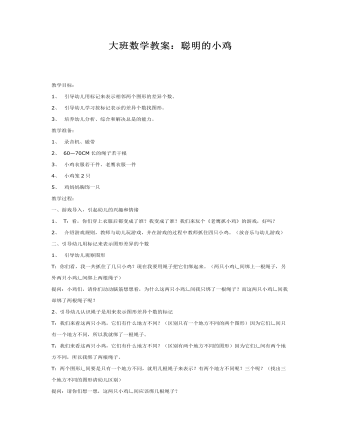
大班数学教案:聪明的小鸡
2、 引导幼儿学习按标记表示的差异个数找图形。 3、 培养幼儿分析、综合和解决总是的能力。 教学准备: 1、 录音机、磁带 2、 60—70CM长的绳子若干根 3、 小鸡衣服若干件、老鹰衣服一件 4、 小鸡笼2只 5、 鸡妈妈胸饰一只 教学过程: 一、游戏导入,引起幼儿的兴趣和情绪 1、 T:看,你们穿上衣服后都变成了谁?我变成了谁?我们来玩个《老鹰抓小鸡》的游戏,好吗? 2、 介绍游戏规则,教师与幼儿玩游戏,并在游戏的过程中教师抓住四只小鸡。(放音乐与幼儿游戏)
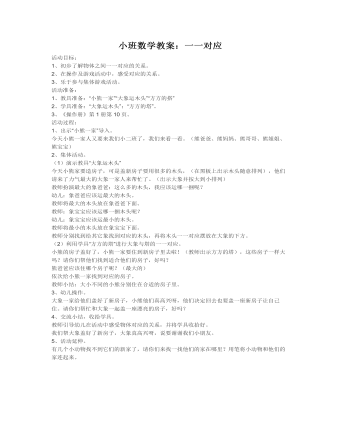
小班数学教案:一一对应
2、在操作及游戏活动中,感受对应的关系。 3、乐于参与集体游戏活动。 活动准备: 1、教具准备:“小熊一家”“大象运木头”“方方的搭” 2、学具准备:“大象运木头”;“方方的塔”。 3、《操作册》第1册第10页。 活动过程: 1、出示“小熊一家”导入。 今天小熊一家人又要来我们小二班了,我们来看一看。(熊爸爸、熊妈妈、熊哥哥、熊姐姐、熊宝宝)
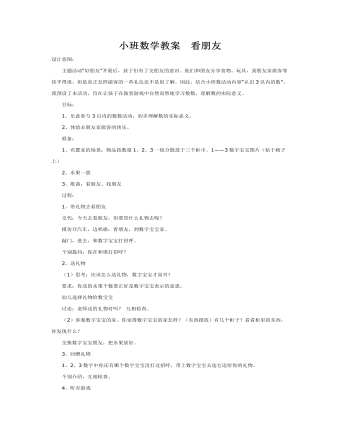
小班数学教案 看朋友
目标: 1、乐意参与3以内的数数活动,初步理解数的实际意义。 2、体验去朋友家做客的快乐。 准备: 1、布置家的场景:物品按数量1、2、3一组分散放于三个柜中。1——3数字宝宝图片(粘于椅子上) 2、水果一篮 3、歌曲:看朋友、找朋友 过程: 1、带礼物去看朋友 交代:今天去看朋友,但要带什么礼物去呢? 模仿开汽车,边唱歌:看朋友,到数字宝宝家。 敲门,进去,和数字宝宝打招呼。 个别提问:你在和谁打招呼?
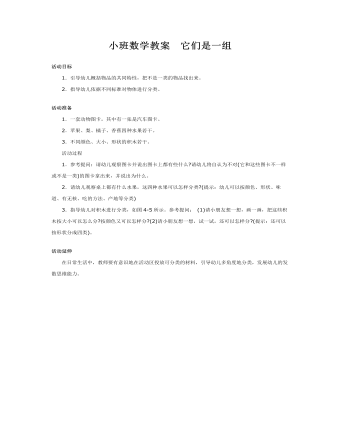
小班数学教案 它们是一组
2.指导幼儿依据不同标准对物体进行分类。活动准备1.一套动物图卡,其中有一张是汽车图卡。2.苹果、梨、橘子、香蕉四种水果若干。3.不同颜色、大小、形状的积木若干。 活动过程1.参考提问:请幼儿观察图卡并说出图卡上都有些什么?请幼儿将自认为不对(它和这些图卡不一样或不是一类)的图卡拿出来,并说出为什么。

人教版高中数学选择性必修二变化率问题教学设计
导语在必修第一册中,我们研究了函数的单调性,并利用函数单调性等知识,定性的研究了一次函数、指数函数、对数函数增长速度的差异,知道“对数增长” 是越来越慢的,“指数爆炸” 比“直线上升” 快得多,进一步的能否精确定量的刻画变化速度的快慢呢,下面我们就来研究这个问题。新知探究问题1 高台跳水运动员的速度高台跳水运动中,运动员在运动过程中的重心相对于水面的高度h(单位:m)与起跳后的时间t(单位:s)存在函数关系h(t)=-4.9t2+4.8t+11.如何描述用运动员从起跳到入水的过程中运动的快慢程度呢?直觉告诉我们,运动员从起跳到入水的过程中,在上升阶段运动的越来越慢,在下降阶段运动的越来越快,我们可以把整个运动时间段分成许多小段,用运动员在每段时间内的平均速度v ?近似的描述它的运动状态。

人教版高中数学选修3离散型随机变量及其分布列(1)教学设计
4.写出下列随机变量可能取的值,并说明随机变量所取的值表示的随机试验的结果.(1)一个袋中装有8个红球,3个白球,从中任取5个球,其中所含白球的个数为X.(2)一个袋中有5个同样大小的黑球,编号为1,2,3,4,5,从中任取3个球,取出的球的最大号码记为X.(3). 在本例(1)条件下,规定取出一个红球赢2元,而每取出一个白球输1元,以ξ表示赢得的钱数,结果如何?[解] (1)X可取0,1,2,3.X=0表示取5个球全是红球;X=1表示取1个白球,4个红球;X=2表示取2个白球,3个红球;X=3表示取3个白球,2个红球.(2)X可取3,4,5.X=3表示取出的球编号为1,2,3;X=4表示取出的球编号为1,2,4;1,3,4或2,3,4.X=5表示取出的球编号为1,2,5;1,3,5;1,4,5;2,3,5;2,4,5或3,4,5.(3) ξ=10表示取5个球全是红球;ξ=7表示取1个白球,4个红球;ξ=4表示取2个白球,3个红球;ξ=1表示取3个白球,2个红球.

人教版高中数学选修3离散型随机变量的方差教学设计
3.下结论.依据均值和方差做出结论.跟踪训练2. A、B两个投资项目的利润率分别为随机变量X1和X2,根据市场分析, X1和X2的分布列分别为X1 2% 8% 12% X2 5% 10%P 0.2 0.5 0.3 P 0.8 0.2求:(1)在A、B两个项目上各投资100万元, Y1和Y2分别表示投资项目A和B所获得的利润,求方差D(Y1)和D(Y2);(2)根据得到的结论,对于投资者有什么建议? 解:(1)题目可知,投资项目A和B所获得的利润Y1和Y2的分布列为:Y1 2 8 12 Y2 5 10P 0.2 0.5 0.3 P 0.8 0.2所以 ;; 解:(2) 由(1)可知 ,说明投资A项目比投资B项目期望收益要高;同时 ,说明投资A项目比投资B项目的实际收益相对于期望收益的平均波动要更大.因此,对于追求稳定的投资者,投资B项目更合适;而对于更看重利润并且愿意为了高利润承担风险的投资者,投资A项目更合适.

人教版高中数学选修3离散型随机变量的均值教学设计
对于离散型随机变量,可以由它的概率分布列确定与该随机变量相关事件的概率。但在实际问题中,有时我们更感兴趣的是随机变量的某些数字特征。例如,要了解某班同学在一次数学测验中的总体水平,很重要的是看平均分;要了解某班同学数学成绩是否“两极分化”则需要考察这个班数学成绩的方差。我们还常常希望直接通过数字来反映随机变量的某个方面的特征,最常用的有期望与方差.二、 探究新知探究1.甲乙两名射箭运动员射中目标靶的环数的分布列如下表所示:如何比较他们射箭水平的高低呢?环数X 7 8 9 10甲射中的概率 0.1 0.2 0.3 0.4乙射中的概率 0.15 0.25 0.4 0.2类似两组数据的比较,首先比较击中的平均环数,如果平均环数相等,再看稳定性.假设甲射箭n次,射中7环、8环、9环和10环的频率分别为:甲n次射箭射中的平均环数当n足够大时,频率稳定于概率,所以x稳定于7×0.1+8×0.2+9×0.3+10×0.4=9.即甲射中平均环数的稳定值(理论平均值)为9,这个平均值的大小可以反映甲运动员的射箭水平.同理,乙射中环数的平均值为7×0.15+8×0.25+9×0.4+10×0.2=8.65.

人教版高中数学选修3离散型随机变量及其分布列(2)教学设计
温故知新 1.离散型随机变量的定义可能取值为有限个或可以一一列举的随机变量,我们称为离散型随机变量.通常用大写英文字母表示随机变量,例如X,Y,Z;用小写英文字母表示随机变量的取值,例如x,y,z.随机变量的特点: 试验之前可以判断其可能出现的所有值,在试验之前不可能确定取何值;可以用数字表示2、随机变量的分类①离散型随机变量:X的取值可一、一列出;②连续型随机变量:X可以取某个区间内的一切值随机变量将随机事件的结果数量化.3、古典概型:①试验中所有可能出现的基本事件只有有限个;②每个基本事件出现的可能性相等。二、探究新知探究1.抛掷一枚骰子,所得的点数X有哪些值?取每个值的概率是多少? 因为X取值范围是{1,2,3,4,5,6}而且"P(X=m)"=1/6,m=1,2,3,4,5,6.因此X分布列如下表所示

人教版高中数学选修3一元线性回归模型及其应用教学设计
1.确定研究对象,明确哪个是解释变量,哪个是响应变量;2.由经验确定非线性经验回归方程的模型;3.通过变换,将非线性经验回归模型转化为线性经验回归模型;4.按照公式计算经验回归方程中的参数,得到经验回归方程;5.消去新元,得到非线性经验回归方程;6.得出结果后分析残差图是否有异常 .跟踪训练1.一只药用昆虫的产卵数y与一定范围内的温度x有关,现收集了6组观测数据列于表中: 经计算得: 线性回归残差的平方和: ∑_(i=1)^6?〖(y_i-(y_i ) ?)〗^2=236,64,e^8.0605≈3167.其中 分别为观测数据中的温度和产卵数,i=1,2,3,4,5,6.(1)若用线性回归模型拟合,求y关于x的回归方程 (精确到0.1);(2)若用非线性回归模型拟合,求得y关于x回归方程为 且相关指数R2=0.9522. ①试与(1)中的线性回归模型相比较,用R2说明哪种模型的拟合效果更好 ?②用拟合效果好的模型预测温度为35℃时该种药用昆虫的产卵数.(结果取整数).
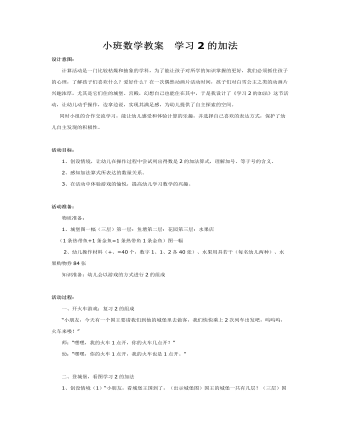
小班数学教案 学习2的加法
活动目标:1、创设情境,让幼儿在操作过程中尝试列出得数是2的加法算式,理解加号、等于号的含义。2、感知加法算式所表达的数量关系。3、在活动中体验游戏的愉悦,提高幼儿学习数学的兴趣。 活动准备: 物质准备:1、城堡图一幅(三层)第一层:鱼塘第二层:花园第三层:水果店 (1条热带鱼+1条金鱼=1条热带鱼1条金鱼)图一幅 2、幼儿操作材料(+、=40个,数字1、1、2各40张)、水果用具若干(每名幼儿两种)、水果购物券84张 知识准备:幼儿会以游戏的方式进行2的组成
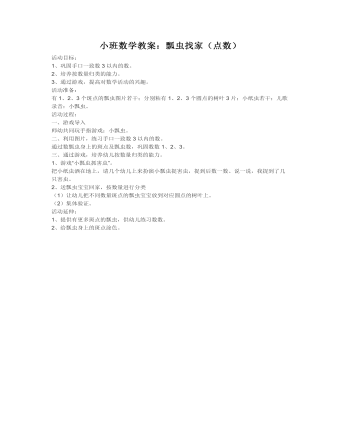
小班数学教案:瓢虫找家(点数)
2、培养按数量归类的能力。 3、通过游戏,提高对数学活动的兴趣。 活动准备: 有1、2、3个斑点的瓢虫图片若干;分别粘有1、2、3个圆点的树叶3片;小纸虫若干;儿歌录音:小瓢虫。 活动过程: 一、游戏导入 师幼共同玩手指游戏:小瓢虫。 二、利用图片,练习手口一致数3以内的数。 通过数瓢虫身上的斑点及瓢虫数,巩固数数1、2、3。
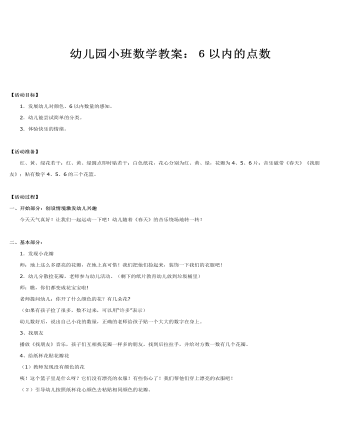
小班数学教案 6以内的点数
【活动目标】1.发展幼儿对颜色、6以内数量的感知。2.幼儿能尝试简单的分类。3.体验快乐的情绪。 【活动准备】 红、黄、绿花若干;红、黄、绿圆点即时贴若干;白色纸花,花心分别为红、黄、绿,花瓣为4、5、6片;音乐磁带《春天》《找朋友》;贴有数字4、5、6的三个花篮。
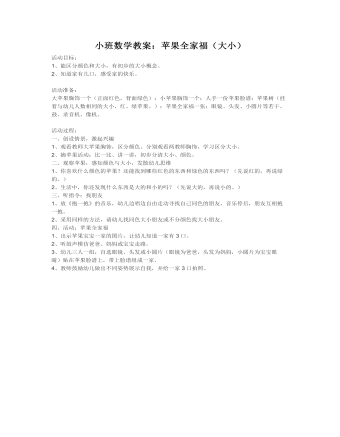
小班数学教案:苹果全家福(大小)
2、知道家有几口,感受家的快乐。 活动准备: 大苹果胸饰一个(正面红色,背面绿色);小苹果胸饰一个;人手一份苹果脸谱;苹果树(挂着与幼儿人数相同的大小,红、绿苹果。);苹果全家福一张;眼镜、头发、小圆片等若干。鼓、录音机、像机。 活动过程: 一、创设情景,激起兴趣 1、观看教师大苹果胸饰,区分颜色。分别观看两教师胸饰,学习区分大小。 2、摘苹果活动:比一比、讲一讲,初步分清大小、颜色。
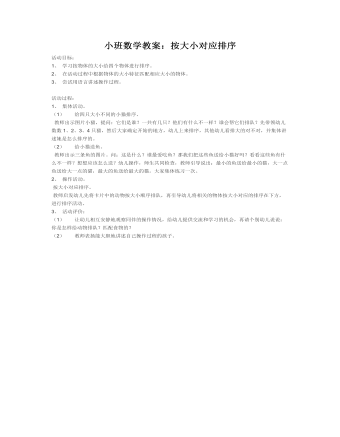
小班数学教案:按大小对应排序
2、 在活动过程中根据物体的大小特征匹配相应大小的物体。3、 尝试用语言讲述操作过程。活动过程:1、 集体活动。 (1) 给四只大小不同的小猫排序。 教师出示图片小猫,提问:它们是谁?一共有几只?他们有什么不一样?谁会帮它们排队?先带领幼儿数数1、2、3、4只猫,然后大家确定开始的地方,幼儿上来排序,其他幼儿看排大的对不对,并集体讲述她是怎么排序的。(2) 给小猫送鱼。 教师出示三条鱼的图片。问:这是什么?谁最爱吃鱼?那我们把这些鱼送给小猫好吗?看看这些鱼有什么不一样?想想应该怎么送?幼儿操作,师生共同检查,教师引导说出:最小的鱼送给最小的猫,大一点鱼送给大一点的猫,最大的鱼送给最大的猫。大家集体练习一次。

小班数学教案:小动物变魔术
2、乐意参加操作活动,体验成功的快乐。 活动准备: 1、范图;各种小动物的拼图。 3、幼儿用书人手一本。 活动过程: 1、观察完整的小动物拼图。 教师出示完整的小动物拼图。宝宝们,你们看,老师带来了什么?你们认识它们吗? 引导幼儿跟每个小动物问好。

新人教版高中英语必修3Unit 1 Festivals and celebrations-Discovering Useful Structure教学设计
4.That was an experience that frightened everyone. →That was _____________________. 答案:1. taking 2. being discussed 3. in the reading room 4. a frightening experienceStep 6 The meaning and function of V-ing as the predicative动词-ing形式作表语,它通常位于系动词后面,用以说明主语“是什么”或“怎么样”一种表示主语的特质、特征和状态, 其作用相当于形容词; 另一种具体说明主语的内容, 即主语等同于表语, 两者可互换。The music they are playing sounds so exciting. 他们演奏的音乐听起来令人激动。The result is disappointing. 结果令人失望。Our job is playing all kinds of music. 我们的工作就是演奏各种音乐。Seeing is believing. 眼见为实。Step 7 Practice1. It is ________(amaze) that the boy is able to solve the problem so quickly.2. Buying a car is simply _______(waste) money. 3. Please stop making the noise—it’s getting ________(annoy). 4. complete the passage with the appropriate -ing form.La Tomatina is a festival that takes place in the Spanish town Bunol every August. I think many food festivals are __________ because people are just eating. however, this festival is _________ because people don't actually eat the tomatoes. Instead, they throw them at each other! the number of people ________ part in this tomato fight, can reach up to 20,000, and it is a very __________ fight that lasts for a whole hour. The _______ thing is how clean Bunol is after the tomatoes are washed away after the fight. this is because the juice form tomatoes is really good for making surfaces clean!答案:1. amazing 2. wasting 3. annoying4. boring interesting taking exciting amazing

新人教版高中英语必修3Unit 1 Festivals and Celebrations-Reading and Thinking教学设计
The topic of this part is “Discover the reasons for festivals and celebrations.The Listening & Speaking & Talking part aims at talking about the experiences and feelings or emotions about the festivals and celebrations. This section aims at detecting the reason why the people celebrate the festivals, the time, the places, the types and the way of celebrations. It also explains why some traditions in the old celebrations are disappearing, like the firecrackers in the big cities and some new things are appearing like the prosperity of business or commerce. 1. Students can talk about what festivals they know and the reasons and the way of celebrating them.2. Students should learn the reading skills such as the headline and get the topic sentences, the structures of articles.3. Students can understand the past, the present situation of some festival around the world and why there are some changes about them. 4. Students can have the international awareness about the festivals.1. Students should learn the reading skills such as the headline and get the topic sentences, the structures of articles.2. Students can understand the past, the present situation of some festival around the world and why there are some changes about them.Step 1 Lead in---Small talkWhat festival do you like best ? Why ?I like the Spring Festivals because I can set off the fireworks, receive the lucky money and enjoy the Gala with my families.Step 2 Before reading---Pair workWhy do people celebrate different festivals ?The Spring Festivals is to celebrate the end of winter and the coming of spring and new life.The Mid-autumn Day is to celebrate the harvest and admire the moon.

新人教版高中英语必修3Unit 1 Festivals and Celebrations-Listening &Speaking&Talking教学设计
The theme of this section is “Talk about festival activities and festival experiences”.Festival and holiday is a relaxing and interesting topic for students. This part talks about the topic from the daily life of students’. In the part A ---Listening and Speaking, there are three conversations among different speakers from three countries(Japan, Rio and China), where the speakers are participating in or going to participate in the festivals and celebrations. So listening for the relationship among them is a fundamental task. Actually, with the globalization and more international communication, it is normal for Chinese or foreigners to witness different festivals and celebrations in or out of China. In the Conversation 1, a foreign reporter is interviewing a Japanese young girl who just had participated in the ceremony of the Coming-of-Age Day on the street and asking her feeling about the ceremony and the afterwards activities. Conversation 2, Chinese girl Li Mei is witnessing the Rio Carnival for the first time, and her friend Carla gives her some advice on the costumes which enables her to match with the carnival to have a good time. Conversation 3, a Chinese guide is showing a group of foreign visitors around the Lantern Festival and introducing the customs of the festival to them. The three conversations have a strong vitality and insert the festival and cultural elements from different countries. So perceiving the festivals and cultures from different countries is the second task. At the same time, the scripts also insert the targeted grammar --- v-ing as attributive and predicative, which students can perceive and experience in a real context and make a road for the further study. That is the third task. In the Part B--- Listening and Talking, the theme is “Talk about festival experience”, which is the common topic in our daily conversations. During the conversation, Song Lin, a Chinese student, asked Canadian friend Max about how to spend Christmas. In the conversation, Song Lin talked about experience and the feelings during the Chinese Spring Festival, during which there are not only some enjoyable things but some unpleasant things. After the listening, perhaps students find there are some similarities between Christmas and the Chinese Spring Festival as there are some differences in the origins and celebrations. For example, people always visit friends and relatives, decorate their houses, have a big dinner together, chat and give presents to each other.

新人教版高中英语必修3Unit 1 Festivals and Celebrations-Reading for writing教学设计二
Step 3 Analyzing article structureActivity 31. Teachers raise questions to guide students to analyze the chapter structure of this diary and think about how to describe the festival experience. (1)What should be included in the opening/body/closing paragraph(s)?(2)How did the writer arrange his/her ideas?(3)What kind of interesting details did the writer describe?(4)How did the writer describe his/her feelings/emotions during the event?2. Students read and compare the three sentence patterns in activity 2. Try to rewrite the first paragraph of the diary with these three sentence patterns. After that, students exchange corrections with their partners. Such as:●This was my first time spending three days experiencing the Naadam Festival in China’s Inner Mongolia Autonomous Region and it was an enjoyable and exciting experience. ●I'll never forget my experience at the Naadam Festival because it was my first time to watch the exciting Mongolian games of horse racing, wrestling, and archery so closely. ●I'll always remember my first experience at the Naadam Festival in China’s Inner Mongolia Autonomous Region because it was so amazing to spend three days witnessing a grand Mongolian ceremony. Step 4 Accumulation of statementsActivity 41. Ask the students to read the diary again. Look for sentences that express feelings and emotions, especially those with the -ing form and the past participle. Such as:● …horse racing, wrestling, and archery, which are all so exciting to watch. ● some amazing performances● I was surprised to see…● I was a little worried about. . . ● feeling really tiredOther emotional statements:●I absolutely enjoyed the archery, too, but the horse races were my favourite part. ●I'm finally back home now, feeling really tired, but celebrating Naadam with my friend was totally worth it. ●He invited me back for the winter to stay in a traditional Mongolian tent and cat hot pot. I can’t wait!2. In addition to the use of the -ing form and the past participle, the teacher should guide the students in the appreciation of these statements, ask them to memorize them, and encourage them to use them reasonably in writing practice.